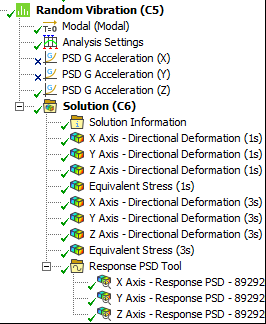Ansys Learning Forum › Forums › Discuss Simulation › General Mechanical › Questions regarding Modal Analysis and Random Vibration Analysis › Reply To: Questions regarding Modal Analysis and Random Vibration Analysis
May 18, 2022 at 8:10 am
Subscriber
Further questions (not enough room in one post):
Question 4: Type of support
PSD G Acceleration ÔÇô Should I always select All Supports here? All Ansys-videos I watched have used All Supports, but they are not specific about why. LetÔÇÖs say that IÔÇÖve used fixed support in my modal analysis, will it make any difference if I use Fixed Support or All Supports?
Question 5: Random vibration in x,y,z
Can I apply PSD G Acceleration in X, Y and Z during same simulation or do I need to take them separately? I assume separately. What is happening when I use PSD G in x,y,z simultaneously? I notice that the results change a bit.
/forum/discussion/10768/combining-multi-axis-psd-vibration-results

Question 6: What does the PSD Tool tells me, i.e. what does the PSD counts tell me? I've problem understanding this, perhaps one can use the curves below to ease explanation.
According to Mechanical User’s Guide: “You can apply a Response PSD Tool to any Random Vibration analysis (only) in order to control the frequency sampling of Response PSD probes.”
This is result when performing PSD G Acceleration in X/Y/Z-direction, see below. I assume that one only examine the Response PSD in the direction of the PSD G Acceleration, one at a time.
Since this Response PSD is measured on a vertex, is it the same as when we apply accelerometers (x,y,z)?
X:

Y:

Z:
 Question 7: What is your recommendation, total deformation and equivalent stress in 1-sigma, 2-sigma or 3-sigma? It seems conservative to use 3-sigma (which is easier to motivate).
Question 7: What is your recommendation, total deformation and equivalent stress in 1-sigma, 2-sigma or 3-sigma? It seems conservative to use 3-sigma (which is easier to motivate).
Meachanical User’s Guide: “Meaningful equivalent stress is computed using a special algorithm by Segalman-Fulcher. Note that the probability distribution for this equivalent stress is neither Gaussian nor is the mean value zero. However, the “3 σ” rule (multiplying the RMS value by 3) yields a conservative estimate on the upper bound of the equivalent stress.”
Kind regards
Albin
Question 4: Type of support
PSD G Acceleration ÔÇô Should I always select All Supports here? All Ansys-videos I watched have used All Supports, but they are not specific about why. LetÔÇÖs say that IÔÇÖve used fixed support in my modal analysis, will it make any difference if I use Fixed Support or All Supports?
Question 5: Random vibration in x,y,z
Can I apply PSD G Acceleration in X, Y and Z during same simulation or do I need to take them separately? I assume separately. What is happening when I use PSD G in x,y,z simultaneously? I notice that the results change a bit.
/forum/discussion/10768/combining-multi-axis-psd-vibration-results

Question 6: What does the PSD Tool tells me, i.e. what does the PSD counts tell me? I've problem understanding this, perhaps one can use the curves below to ease explanation.
According to Mechanical User’s Guide: “You can apply a Response PSD Tool to any Random Vibration analysis (only) in order to control the frequency sampling of Response PSD probes.”
This is result when performing PSD G Acceleration in X/Y/Z-direction, see below. I assume that one only examine the Response PSD in the direction of the PSD G Acceleration, one at a time.
Since this Response PSD is measured on a vertex, is it the same as when we apply accelerometers (x,y,z)?
X:

Y:

Z:
 Question 7: What is your recommendation, total deformation and equivalent stress in 1-sigma, 2-sigma or 3-sigma? It seems conservative to use 3-sigma (which is easier to motivate).
Question 7: What is your recommendation, total deformation and equivalent stress in 1-sigma, 2-sigma or 3-sigma? It seems conservative to use 3-sigma (which is easier to motivate).Meachanical User’s Guide: “Meaningful equivalent stress is computed using a special algorithm by Segalman-Fulcher. Note that the probability distribution for this equivalent stress is neither Gaussian nor is the mean value zero. However, the “3 σ” rule (multiplying the RMS value by 3) yields a conservative estimate on the upper bound of the equivalent stress.”
Kind regards
Albin


